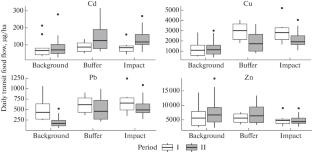Participation of Small Mammals in the Biogenic Transit of Trace Elements under Chemical Pollution of the Environment
Abstract—The paper considers the participation of small mammals (SM) in the migration of essential (Cu, Zn) and toxic (Cd, Pb) trace elements (TEs) in forest ecosystems under conditions of severe industrial pollution of the environment (1990–2000) by a large copper smelter (Middle Urals, Russia) and after a significant reduction of its emissions (2010–2019). The peculiarity of transit food flows (TFF) in the pollution gradient was determined by the composition and abundance of animals of different trophic groups (phytophages, mixophages, zoophages), as well as the specifics of their diet. The reduction of emissions was accompanied by positive changes in the SM communities expressed in an increase in the abundance of some species and structural rearrangements of trophic groups (TG), which led to partial changes in the composition and amount of food consumed, as well as the concentrations of TEs in them. By the end of the observation period in the background zone, the animal-controlled TFFs remained stable for most TEs (Cu, Zn, Cd), and decreased by a factor of 2 for Pb, but not as a result of reduced emissions. At the polluted areas, the TFF value has not changed for Zn, has increased for Cd, and has decreased for Cu and Pb. It was concluded that in the taiga zone the main contribution to the dynamics of biogenic TEs flows in time and space was made by a group of mixophages that dominated in the pollution gradient.


 求助内容:
求助内容: 应助结果提醒方式:
应助结果提醒方式:


